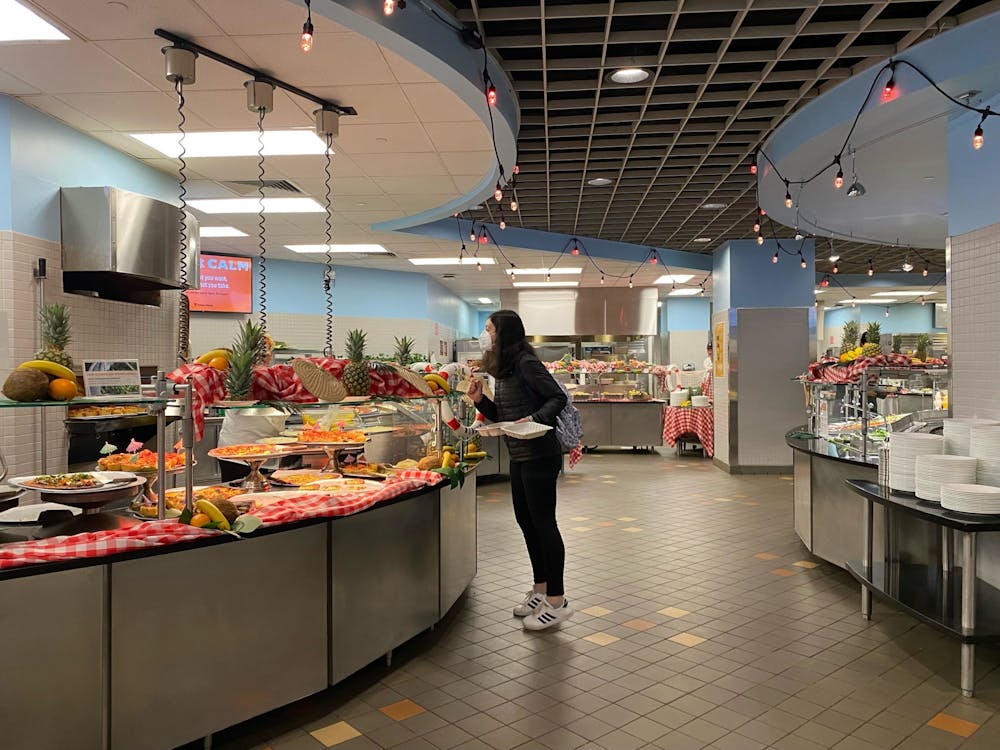Non-Natives ‘celebrating’ with a ‘lūʻau,’ wearing tacky aloha clothing, or giving out plastic leis reminiscent of the hapa-haole hula era is nothing unheard of. Hawaiʻi has always been seen as a place for tourists to frequent and act as spectators to obscure representations of Native Hawaiian culture on display.
And so, when I saw that Whitman’s “Dining Theme Meal” was commemorating an old (and highly problematic) TV show, “Gilligan’s Island,” in addition to serving “Hawaiian” food (note: I have never heard of the dishes “Hawaiian coconut chicken soup” and “Hawaiian fried rice” in my entire life), it was upsetting, but not entirely unsurprising. Even so, I couldn’t help but be unsettled by the gradual implementation of ‘tropical’ decor and the parody sign with the phrase “exotic locales” in the dining hall.
I am very appreciative of the dining hall staff modifying everything upon understanding its offensiveness. In spite of that, I think that the fact that such a misunderstanding still occurred shows the need for clarification.
Although Native Hawaiian culture being used for ‘party’ spectacles has been heavily normalized, this fact doesn’t make it acceptable. Utilizing Hawaiian culture as a ‘social’ event for non-Hawaiians, who likely don’t know much about Hawaiian culture or history, is deeply harmful. It just adds to the exoticization and warped imagery that has defined Hawaiʻi and Native Hawaiians since the times of the illegal overthrow.
With that in mind, there are many things to be said about this particular situation. First of all, the entire premise of “Gilligan’s Island” is built on twisted and racist representations of Native people. The show continuously plays on stereotypes (usually through brownface, may I add) of Native individuals being primitive, violent, and unintelligent.
Indeed, their only verbal communication in the show is shown through gibberish or grunts, and, essentially, the only behaviors expressed by them were acts of aggression towards the other characters. Even though the show depicted a ‘fictional’ community, this portrayal has undoubtedly trickled into the ways people view other Native and Indigenous groups. This is illustrated in the very way that “Gilligan’s Island” was being celebrated at a dinner event with “Hawaiian” food.
To merge “Gilligan’s Island” with “Hawaiian” food is to put aspects of both subjects on the same level; it creates a link between Native Hawaiian culture and the show’s ideas of Indigenous and Native cultures. It does not matter whether the show was associated with Hawaiʻi or not. The connection remains there, all the same.
Besides the matter of celebrating “Gilligan’s Island” itself, another issue arises from the decor and dishes served at the dinner event, which enact attitudes of exoticizing and commodifying Hawaiian culture and disregard cultural significance.

The vaguely depicted kiʻi ‘decor’ (more commonly known as the Māori word, tiki), which originally lined the dining hall walls before the staff took it down, leans into a behavior of exoticization, while simultaneously homogenizing Polynesian cultures as one due to our similarities (the word tiki itself is not Hawaiian, but is still used to describe anything in its likeness, no matter the culture).
As Pacific Island Times writer Gabriel McCoard noted, the use of kiʻi or tiki in such social events creates “a fascination with the exotic and enjoyment of a fictitious place; a caricature of something that doesn’t exist.” To serve “Hawaiian” dishes that don’t even authentically exist and play up this idea of a ‘tropical oasis’ with ‘decor’ just allows people to welcome a Westernized view of the ‘island culture’ of Hawaiʻi. It encourages people to completely dismiss the existence of Hawaiʻi’s actual history, culture, and the peoples that live there.
With kiʻi being a common sight in emulations of lūʻau, I want to reiterate Native Hawaiian filmmaker and journalist Anne Keala Kelly’s point on this occurrence with these ‘lūʻau’-type social events: “When people throw those parties and give those lei,” she wrote, “It’s so clearly intended to mean as much as one of those party favor whistles you can find at a kid’s birthday celebration.”
While kiʻi are traditionally used for customs such as carving the image of ākua (gods), at these events, they instead serve as decorations for someone’s drinking party or ‘tiki bar.’ And while the act of giving lei is traditionally meant as a sign of love, gratitude, or acknowledgement, people instead give cheap, plastic ones out as unique ‘party favors’ or ‘costumes.’

If you desire to learn more about these aspects of Hawaiian culture, then learn about the history of lūʻau, its historical and cultural significance, and why it shouldn’t be used as a ‘fun’ party theme for non-Hawaiians. Learn about traditional Hawaiian foods, like poi or lau lau. Learn about Hawaiian history, in general.
Of course, something like a ‘beach day party’ is fine. However, when people start associating Hawaiian culture with party events, mimicking cultural practices, and celebrating harmful depictions of Native people, they not only misrepresent and disregard who we are as people, but they commodify our culture — it becomes something merely used as entertainment for the amusement of non-Hawaiians.
Gisele Bisch is a first-year from the North Shore of Oʻahu (Hawai‘i) who plans to concentrate in Anthropology on the Sociocultural Track. She can be reached at gb8528@princeton.edu.








